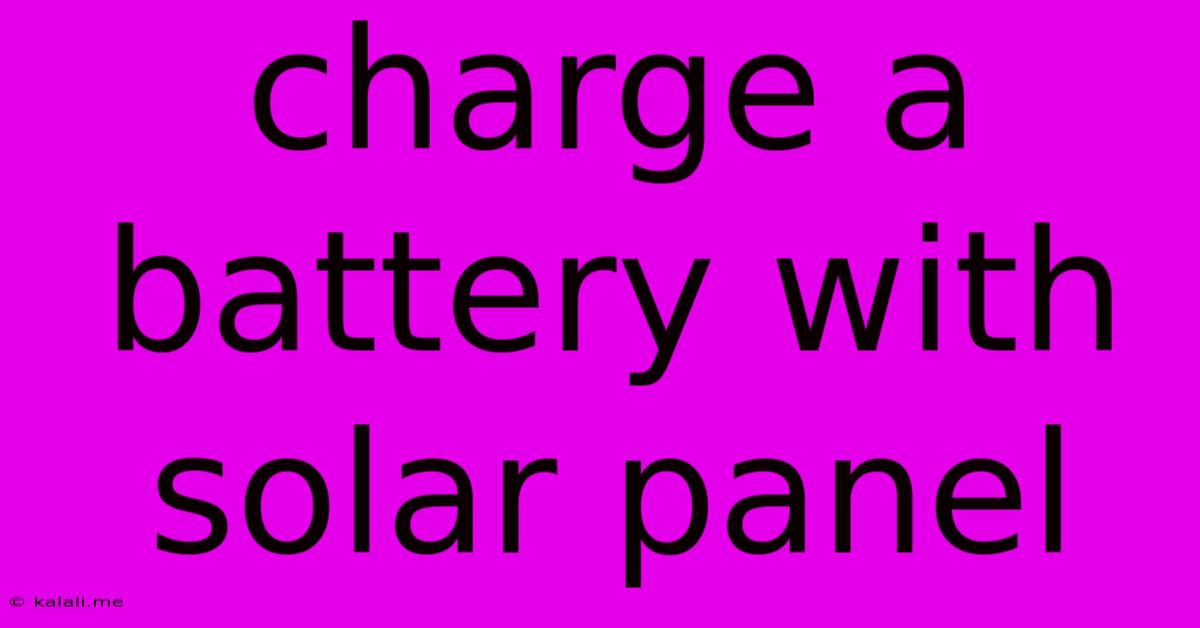Charge A Battery With Solar Panel
Kalali
May 27, 2025 · 3 min read

Table of Contents
Charging a Battery with a Solar Panel: A Comprehensive Guide
Meta Description: Learn how to effectively charge a battery using a solar panel. This guide covers essential components, wiring diagrams, safety precautions, and optimization techniques for maximizing your solar charging setup.
Harnessing the power of the sun to charge your batteries is a rewarding and increasingly popular way to achieve energy independence. Whether you're powering a small off-grid cabin, a remote campsite, or simply want a backup power solution, understanding how to charge a battery with a solar panel is crucial. This comprehensive guide will walk you through the process, covering everything from selecting the right components to optimizing your setup for maximum efficiency.
Choosing the Right Components:
The core components of a solar battery charging system include:
-
Solar Panel: The size of the solar panel determines the amount of power it generates. Consider your battery's capacity and your energy needs when choosing a panel's wattage (measured in Watts, W). Larger panels will charge faster but also cost more. Consider factors like solar panel efficiency and the amount of sunlight your location receives.
-
Battery: The type of battery you choose significantly impacts the charging process. Lead-acid batteries are common and relatively inexpensive, but require careful charging to avoid damage. Lithium-ion batteries are more efficient, longer-lasting, and can handle faster charging rates, but are generally more expensive. Understanding your battery's voltage (V) and ampere-hour (Ah) rating is essential.
-
Charge Controller: This is a crucial component that regulates the flow of electricity from the solar panel to the battery. It prevents overcharging, which can damage your battery, and ensures optimal charging performance. MPPT (Maximum Power Point Tracking) charge controllers are highly recommended for their efficiency, especially in variable sunlight conditions.
-
Wiring and Connectors: Use appropriately sized wires to handle the current your system will produce. Incorrect wiring can lead to overheating and fire hazards. Secure connections with appropriate connectors are essential for safety and reliability. Consider using weatherproof connectors if your system will be exposed to the elements.
Wiring Your Solar Panel to a Battery:
While the specifics may vary depending on your components, the basic wiring configuration is relatively straightforward. Always consult the instructions that came with your specific components. Improper wiring can damage your equipment or create a fire hazard.
A typical setup involves connecting the positive (+) and negative (-) terminals of the solar panel to the corresponding inputs on the charge controller. The output terminals of the charge controller are then connected to the positive (+) and negative (-) terminals of the battery. A fuse should be included in the positive wire near the battery for added protection.
Simple Wiring Diagram (Conceptual):
Solar Panel (+) --> Fuse --> Charge Controller (+) --> Battery (+) Solar Panel (-) --> Charge Controller (-) --> Battery (-)
Safety Precautions:
- Always disconnect the battery before working on the wiring.
- Wear appropriate safety glasses.
- Work in a well-ventilated area.
- Use the correct sized wire and connectors.
- Understand your system's voltage and current ratings.
- Never mix different battery chemistries in the same system.
Optimizing Your Solar Charging System:
-
Panel Angle and Orientation: Orient your solar panel to face the sun directly, ideally south in the Northern Hemisphere and north in the Southern Hemisphere. Adjusting the angle throughout the year can further improve efficiency.
-
Shade Avoidance: Even a small amount of shade can significantly reduce the panel's output. Keep your panel clear of obstructions.
-
Regular Maintenance: Clean your solar panel regularly to remove dust and debris. Inspect your wiring and connections for any signs of damage.
By following these steps, you can successfully charge a battery using a solar panel and enjoy the benefits of clean, renewable energy. Remember to always prioritize safety and consult the manufacturer's instructions for your specific components. With careful planning and execution, you'll be well on your way to harnessing the sun's power to your advantage.
Latest Posts
Latest Posts
-
Are You A Felon If You Havent Been Sentenced
May 28, 2025
-
Water Pressure In Shower Too High
May 28, 2025
-
Why Do My Lights Flicker At Certain Times
May 28, 2025
-
Car Ac Low Side High Pressure
May 28, 2025
-
How To Repair A Soaker Hose
May 28, 2025
Related Post
Thank you for visiting our website which covers about Charge A Battery With Solar Panel . We hope the information provided has been useful to you. Feel free to contact us if you have any questions or need further assistance. See you next time and don't miss to bookmark.